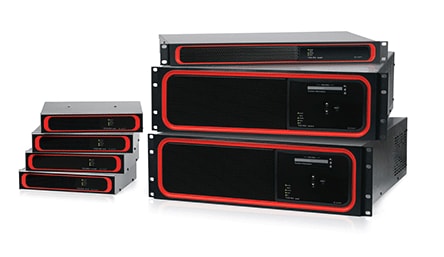You must have attended a video conference where the mic made a humming noise, even as your colleague was speaking. Or maybe the auditorium you were in experienced a lot of noise during the presenter’s speech. If so, you have experienced something quite common. All of this noise is due to the absence of a Digital Signal Processor (DSP).
A DSP prevents audio noise in large spaces, such as an auditorium or a townhall space. These large spaces typically have multiple audio and video devices. A DSP prevents noise in these spaces by converting analogue signals to digital signals, and then back to analogue signals. The goal of DSPs is usually to measure, filter and/or compress continuous real-world analog signals.
You can program a DSP for multiple inputs and outputs to enable high-quality audio and sound. For example, there could be four inputs, one for a DVD, two mics, and one for a video conferencing system. This DSP could also have four outputs, one for video conferencing, one for an amplifier, and two for both mics. There are multiple inputs programmed to multiple outputs. You can connect an input to a suitable output for high-quality sound.
You can also create a matrix for a particular DSP, based on your requirement. DSP cards are also available, so that you can seamlessly program these cards and add many more inputs and outputs for events to be held in a very large space.
DSP has many advantages over analogue processing. It is able to provide far better levels of signal processing than is possible with analogue hardware alone. It is also possible to easily update a digital signal processor by downloading new software. Once a basic DSP card has been developed, it is possible to use this hardware design to operate in several different environments, performing different functions, purely by downloading different software. It is also able to provide functions that would not be possible using analogue techniques.
How a DSP works
As the name suggests, digital signal processing is the processing of signals in a digital form. DSP is based upon the fact that it is possible to build up a representation of the signal in a digital form. This is done by sampling the voltage level at regular time intervals and converting the voltage level at that instant into a digital number proportional to the voltage. This process is performed by a circuit called an analogue to digital converter, A to D converter or ADC.
Once in a digital format the real DSP is able to work. The DSP performs complicated mathematical routines upon the representation of the signal. However to use the signal, it then usually needs to be converted back into an analogue form where it can be amplified and passed into a loudspeaker or headphone. The circuit that performs this function is called a digital to analogue converter, D to A converter or DAC.
Features and characteristics of a DSP
DSPs are equipped to handle real-time processing, that is, they can give an optimal performance even when streaming data is being fed into them.
The memories that are used to store programs are different from the ones used to store data.
It can be used as a direct memory access device in supporting or host environments.
They take analogue signals as input, convert them into the digital form, process the signals and then, convert them back into analogue form.
So, you can install DSPs in several environments, ranging from an auditorium to a video conferencing room, and from a townhall application to a university lecture centre. This will ensure a seamless and high-quality audio experience with minimal noise. Here’s to happy listening…
For more information on how to install a DSP in your home or office, contact Actis at 022-30808080 or at contact@actis.co.in.
(Images courtesy: www.iitb.ac.in and www.biamp.com)

